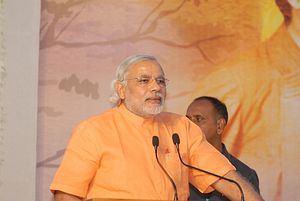Delhi’s usually calm Raisina Hill was bustling with traffic on Monday morning and by the evening it was stuck in a full-blown traffic jam, a rarity on the road that leads to the presidential palace. On the contrary, the usually crowded streets of Delhi presented a calm exterior with less traffic than usual. The forecourt of the President’s House could not have seen so many people at one go in its centuryg-long history. Over 4,000 people came to witness the inauguration of the Narendra Modi-led government in New Delhi on May 26, 2014.
The time for the oath-taking ceremony was fixed at 6 p.m., but visitors were asked to be seated by five. Media personnel were asked to occupy their position by 3:30 p.m. India’s rich and powerful, who generally would not venture out in 44 degree weather, were willing to sweat outside to witness the historic moment. Present among the crowd were India’s richest man, Mukesh Ambani, and popular Bollywood star Salman Khan.
Among the crowd were some saffron robe-wearing saints and priests, who are not generally seen at high profile political events. Their presence was a clear indication that a right-wing Hindu government has taken over the country; they were there to bless a regime which has been formed with their active support. Prospective ministers and some of the newly elected parliamentarians were seen taking their blessings before the start of the ceremony.
What was novel about the event was the presence of the heads of the states of the SAARC (South Asian Association of Regional Cooperation) nations as well as the President of Mauritius. This is the first time so many South Asian leaders were present at the inauguration of a government in India. If the victory celebration of the Bharatiya Janata Party (BJP) on May 16, the day of result, was full of symbolism invoking ancient Hindu kings, the oath-taking ceremony also evoked ancient grandeur. History tells us that many kings used to invite the heads of neighboring kingdoms to their coronation. Modi’s ceremony had an uncanny resemblance to the ancient practice. Modi is a democratically elected leader but his persona today is larger than life. In any private or public discussion it’s the name Modi that is uttered the most. People don’t talk about a BJP government — commentators call this the beginning of India’s “Modi era.”
In another departure from established tradition, supporters chanted Hindu religious slogans like “Jai Sree Ram” (“Hail Lord Ram,” a popular Hindu God). Immediately after Modi took his oath some BJP supporters started shouting the slogan. The same chant was repeated after the national anthem stopped playing. The slogan has been one of the mobilizing calls of the Hindu right since its beginning. It gained currency in 1980s and 90s when this was used to galvanize Hindu cadres against other religious groups.
Along with Modi, 45 ministers also took their oaths. This is said to be by far the leanest cabinet in recent times. Manmohan Singh’s government had over 65 ministers. The new government in Delhi wants to create greater coordination between different ministries, which is why some of India’s old departments have been plugged with the new ones to downsize staff and improve efficiency.
Lots of hope rides on the government which has come to power with a great mandate. So far, the new government has succeeded in continuing its post-electoral momentum and creating a buzz about a new dawn in India. Modi has instructed his cabinet colleagues to work not less than 18 hours a day. Most members of the ministries are over 50 years old and this sort of a work ethic would take a huge toll on their energy and stamina.
During the election campaign, Modi popularized the slogan “Good days are here to come” to catch the imagination of the masses. People lapped up this promise of India’s impending good days. Only time will tell how far the government succeeds in this endeavor.

































